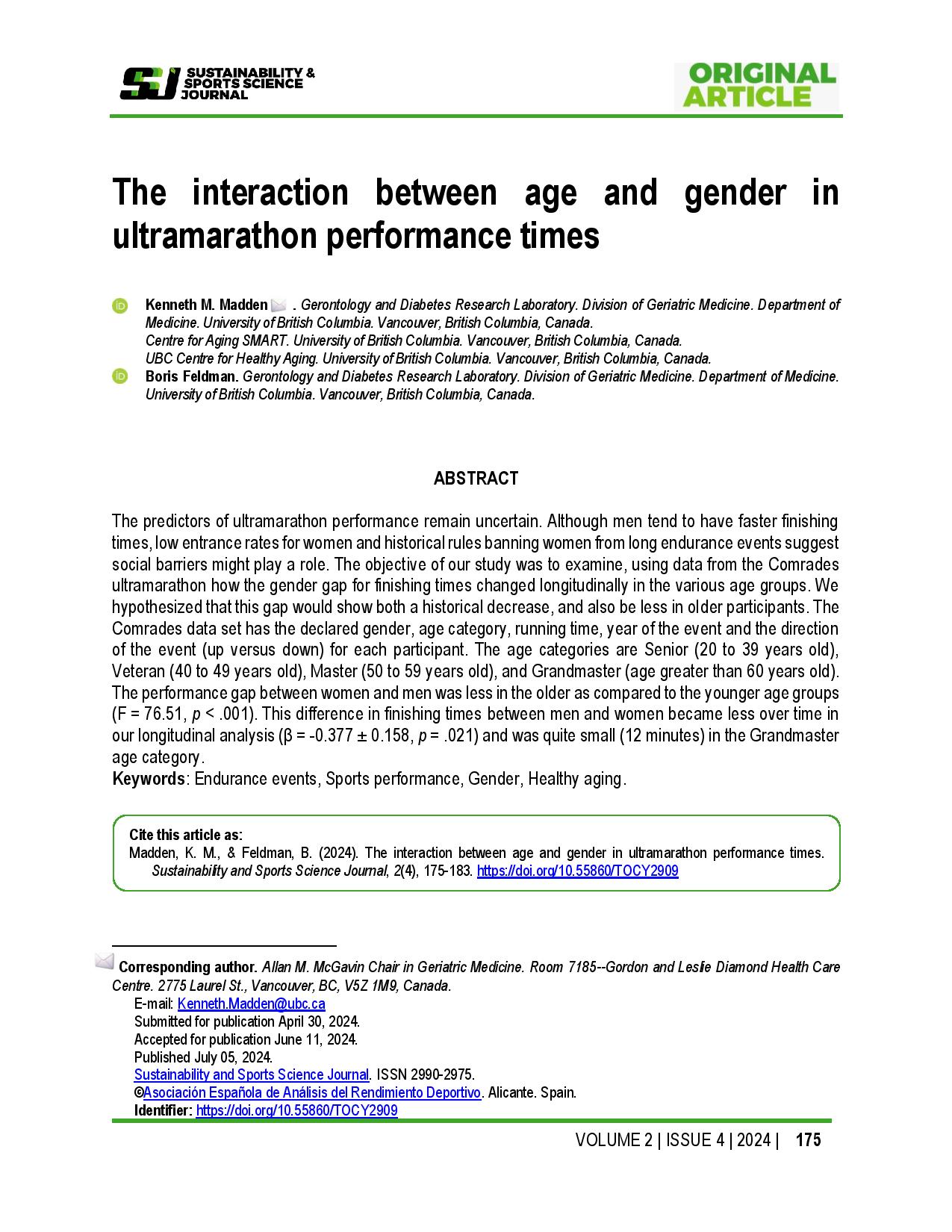The interaction between age and gender in ultramarathon performance times
Main Article Content
Abstract
The predictors of ultramarathon performance remain uncertain. Although men tend to have faster finishing times, low entrance rates for women and historical rules banning women from long endurance events suggest social barriers might play a role. The objective of our study was to examine, using data from the Comrades ultramarathon how the gender gap for finishing times changed longitudinally in the various age groups. We hypothesized that this gap would show both a historical decrease, and also be less in older participants. The Comrades data set has the declared gender, age category, running time, year of the event and the direction of the event (up versus down) for each participant. The age categories are Senior (20 to 39 years old), Veteran (40 to 49 years old), Master (50 to 59 years old), and Grandmaster (age greater than 60 years old). The performance gap between women and men was less in the older as compared to the younger age groups (F = 76.51, p < .001). This difference in finishing times between men and women became less over time in our longitudinal analysis (β = -0.377 ± 0.158, p = .021) and was quite small (12 minutes) in the Grandmaster age category.
Article Details

This work is licensed under a Creative Commons Attribution-NonCommercial-ShareAlike 4.0 International License.
References
Billaut, F., & Bishop, D. (2009). Muscle fatigue in males and females during multiple-sprint exercise. Sports Medicine , 39(4), 257-278. https://doi.org/10.2165/00007256-200939040-00001
Blount, C. (2022). The History of Gender Discrimination in Women's Distance Running: Long-term Consequences and Solutions. Academic Festival. Retrieved from [Accessed 2024, June 20]: https://digitalcommons.sacredheart.edu/acadfest/2022/all/10/
Coates, A. M., Berard, J. A., King, T. J., & Burr, J. F. (2021). Physiological Determinants of Ultramarathon Trail-Running Performance. International Journal of Sports Physiology and Performance, 16(10), 1454-1461. https://doi.org/10.1123/ijspp.2020-0766
Comrades Marathon. (n.d.). Retrieved from [Accessed 2024, June 20]: https://www.comrades.com/
Cooper, P. (1995). Marathon Women and the Corporation. Journal of Women's History, 7(4), 62-81. https://doi.org/10.1353/jowh.2010.0425
Crawley, M. J. (2011). Statistics: An Introduction using R. John Wiley and Sons.
Diaz-Canestro, C., & Montero, D. (2019). Sex Dimorphism of VO2max Trainability: A Systematic Review and Meta-analysis. Sports Medicine , 49(12), 1949-1956. https://doi.org/10.1007/s40279-019-01180-z
East, W. B. (2013). A historical review and analysis of Army physical readiness training and assessment. Combat Studies Institute Press, US Army Combined Arms Center. Retrieved from [Accessed 2024, June 20]: https://apps.dtic.mil/sti/citations/ADA622014
Freund, W., Weber, F., Billich, C., Birklein, F., Breimhorst, M., & Schuetz, U. H. (2013). Ultra-marathon runners are different: investigations into pain tolerance and personality traits of participants of the TransEurope FootRace 2009. Pain Practice: The Official Journal of World Institute of Pain, 13(7), 524-532. https://doi.org/10.1111/papr.12039
Hoffman, M. D., & Krishnan, E. (2013). Exercise behavior of ultramarathon runners: baseline findings from the ULTRA study. Journal of Strength and Conditioning Research / National Strength & Conditioning Association, 27(11), 2939-2945. https://doi.org/10.1519/JSC.0b013e3182a1f261
Knechtle, B., Cuk, I., Villiger, E., Nikolaidis, P. T., Weiss, K., Scheer, V., & Thuany, M. (2022). The Effects of Sex, Age and Performance Level on Pacing in Ultra-Marathon Runners in the "Spartathlon." Sports Medicine - Open, 8(1), 69. https://doi.org/10.1186/s40798-022-00452-9
Knechtle, B., & Nikolaidis, P. T. (2017). The age of the best ultramarathon performance - the case of the "Comrades Marathon." Research in Sports Medicine , 25(2), 132-143. https://doi.org/10.1080/15438627.2017.1282357
Knechtle, B., Scheer, V., Nikolaidis, P. T., & Sousa, C. V. (2020). Participation and Performance Trends in the Oldest 100-km Ultramarathon in the World. International Journal of Environmental Research and Public Health, 17(5). https://doi.org/10.3390/ijerph17051719
Merrett, C. (2007). Race, Gender and Political Dissent in the Comrades Marathon, 1921-1981. Suid-Afrikaanse Historiese Joernaal / Die Suid-Afrikaanse Historiese Vereniging = South African Historical Journal / The South African Historical Society, 59(1), 242-260. https://doi.org/10.1080/02582470709464780
Nikolaidis, P. T., & Knechtle, B. (2020). Performance in 100-km Ultramarathoners-At Which Age, It Reaches Its Peak? Journal of Strength and Conditioning Research / National Strength & Conditioning Association, 34(5), 1409. https://doi.org/10.1519/JSC.0000000000002539
Nikolaidis, P. T., Knechtle, B., Vancini, R., Gomes, M., & Sousa, C. (2021). Participation and Performance in the Oldest Ultramarathon-Comrades Marathon 1921-2019. International Journal of Sports Medicine, 42(07), 638-644. https://doi.org/10.1055/a-1303-4255
Nuzzo, J. L. (2023). Narrative Review of Sex Differences in Muscle Strength, Endurance, Activation, Size, Fiber Type, and Strength Training Participation Rates, Preferences, Motivations, Injuries, and Neuromuscular Adaptations. Journal of Strength and Conditioning Research / National Strength & Conditioning Association, 37(2), 494. https://doi.org/10.1519/JSC.0000000000004329
R Core Team. (2021). R: A Language and Environment for Statistical Computing. R Foundation for Statistical Computing. Retrieved from [Accessed 2024, June 20]: https://www.R-project.org/
Schultz, J. (2019). Breaking into the Marathon: Women's Distance Running as Political Activism. Frontiers: A Journal of Women Studies, 40(2), 1-26. https://doi.org/10.1353/fro.2019.a730151
Senefeld, J., Smith, C., & Hunter, S. K. (2016). Sex Differences in Participation, Performance, and Age of Ultramarathon Runners. International Journal of Sports Physiology and Performance, 11(7), 635-642. https://doi.org/10.1123/ijspp.2015-0418
Stöhr, A., Nikolaidis, P. T., Villiger, E., Sousa, C. V., Scheer, V., Hill, L., & Knechtle, B. (2021). An Analysis of Participation and Performance of 2067 100-km Ultra-Marathons Worldwide. International Journal of Environmental Research and Public Health, 18(2). https://doi.org/10.3390/ijerph18020362
Stratton, K. (2019). Comrades Marathon Results [dataset]. Retrieved from [Accessed 2024, June 20]: https://www.kaggle.com/datasets/suugaku/comrades-marathon-results
Tanous, D., Motevalli, M., Wirnitzer, G., Leitzmann, C., Rosemann, T., Knechtle, B., & Wirnitzer, K. (2022). Sex Differences in Training Behaviors of 10 km to Ultra-Endurance Runners (Part A)-Results from the NURMI Study (Step 2). International Journal of Environmental Research and Public Health, 19(20), 13238. https://doi.org/10.3390/ijerph192013238
Theeboom, T., Beersma, B., & van Vianen, A. E. M. (2014). Does coaching work? A meta-analysis on the effects of coaching on individual level outcomes in an organizational context. The Journal of Positive Psychology, 9(1), 1-18. https://doi.org/10.1080/17439760.2013.837499
ULTRA Running Races & Resources. (n.d.). Retrieved from [Accessed 2024, June 20]: http://www.ultramarathonrunning.com/
Waldvogel, K. J., Nikolaidis, P. T., Di Gangi, S., Rosemann, T., & Knechtle, B. (2019). Women Reduce the Performance Difference to Men with Increasing Age in Ultra-Marathon Running. International Journal of Environmental Research and Public Health, 16(13). https://doi.org/10.3390/ijerph16132377




